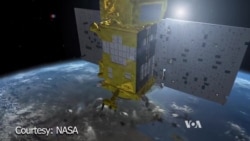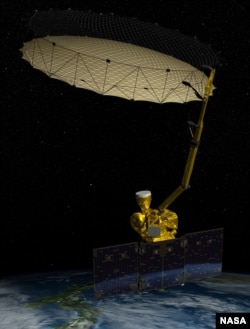NASA is preparing a Thursday, January 29, launch of the first U.S. satellite to observe Earth’s water cycle. The Soil Moisture Active Passive (SMAP) will help scientists better predict extreme weather, climate change, flood and droughts. The new instrument will join four others in what has been the U.S. space agency’s busiest 12-month period in more than a decade.
"That several satellites would be ready to fly at roughly the same time was a remarkable confluence of events," said NASA earth scientist Tom Wagner. “Satellites take a long time to build. Once it goes to space it is really hard to fix it. So a satellite could take three to six years just to build.”
Eyes on Earth's life support systems
The instruments lifted into orbit over the past year are focused on Earth’s vital life support systems and their response to a warmer planet. They bring NASA's fleet of Earth observing probes to 18.
First off the launch pad, last February, was the Global Precipitation Measurement (GPM) mission. “It will be able to measure how much snow is in the atmosphere. That will overall improve our understanding of rainfall," said Wagner.
GPM was followed by the Orbiting Carbon Observatory or OCO-2, which measures how carbon moves through the atmosphere. Wagner said this is important, considering that the CO2 from the burning of fossil fuels in power plants, buildings and transport are a primary driver of global warming.
“We need to know where it is coming from, but we need to know where it goes. Does it get taken up by the ocean? Is it being released by the thawing of the Arctic? And, if we want to figure out where the planet is going to be in 50 or 100 years, those are the kinds of processes we need to understand.”
International Space Station Deploys Instruments
NASA also sent two satellites to the International Space Station, which for the first time was used as a hub to mount Earth observing equipment. Since they were carried as cargo to the space station, the agency did not need separate rockets to deploy them, which saved money.
While the ISS does have some limitations because it orbits around the equator and doesn't pass over the poles, Wagner said, “We can see quite a bit [of the planet].”
Sent to the ISS in September, RapidScat measures how fast winds are moving on the surface of the ocean, providing data which can improve climate models and weather prediction.
The other instrument -- the Cloud-Aerosol Transport System (CATS) -- arrived at the space station in early January. CATS will make critical measurements of clouds and aerosols, two climate change variables most difficult to measure and predict.
Satellite data help climate change response
Wagner said the new satellites provide a necessary checkup on the planet's vital systems.
"And, the simple fact is this: the Earth is all interconnected," he said. "And, if you want to understand it, you need to make measurements all over the place, all the time, so you can get a total picture of what’s going on."
Wagner said satellites are one of the best ways to do that.
The information from them benefits weather forecasters and informs climate models. The data also help farmers and ocean and land managers respond to problems in a warmer world.











